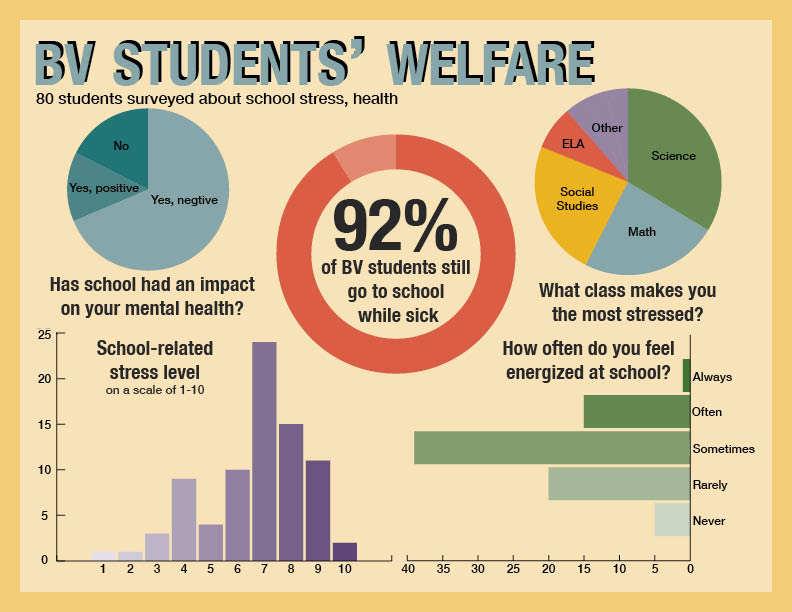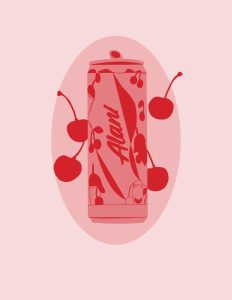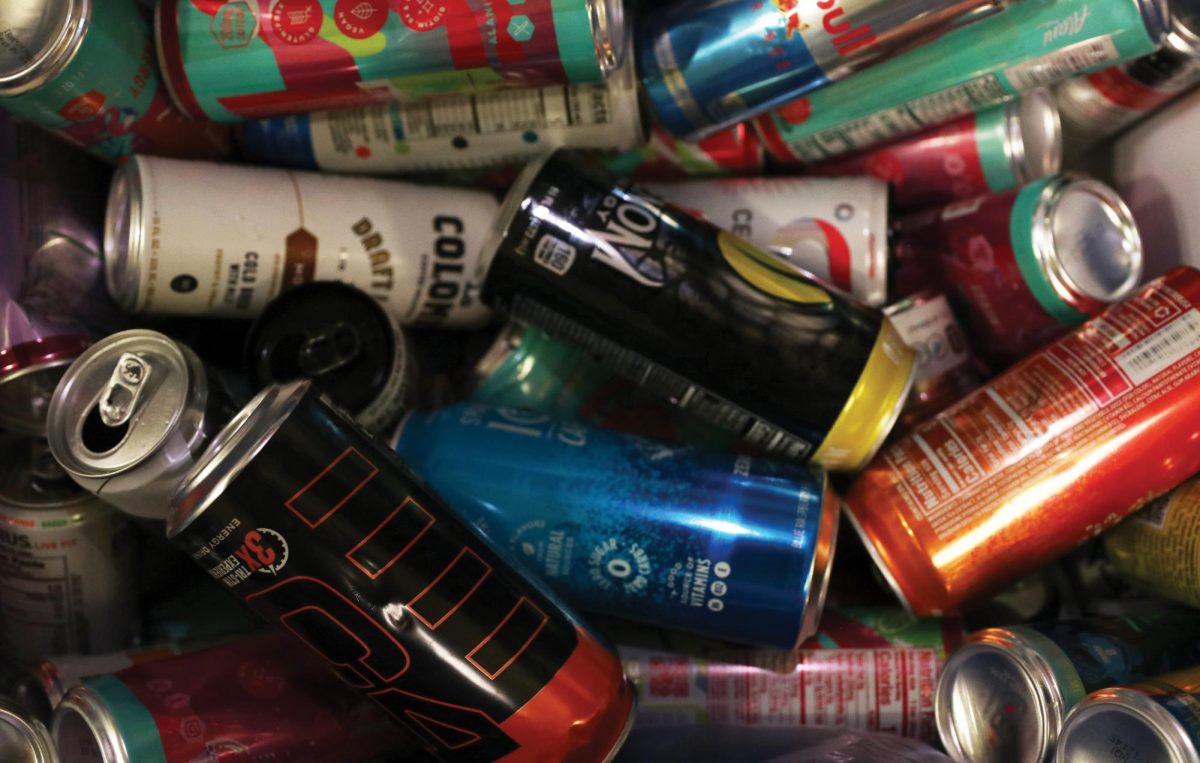The Degradation of Mental Health in Schools
Student, teacher discuss increase in mental health issues
Nutritional No Brainers
Students relish junk food but hunger for modification
A considerable number of Blue Valley High School students describe the school-provided food as unappetizing or small in portion size, often selecting a sugary beverage or pizza. They spend without interruption and net high fees, compelling many to bring personal lunches to school for these common reasons.
The signature plate, found on myplate.gov and in the design of various school lunch trays, gives many a nudge as to how to fill their tray.
At Blue Valley High School, students seemingly don’t need to satisfy the nutritional requirements if they don’t use a tray, so they accompany their under-nutrition by purchasing unhealthy snacks and beverages.
Of the four interviewees from Blue Valley High School, three were displeased with the nutrients in school food, one, sophomore Greer Suttmoeller, said it depends on the day.
“On Wednesdays, the burritos are pretty good,” Suttmoeller said. “But some days, specifically Tuesdays and Thursdays, are lacking on the food. They do okay for the most part, but could definitely do a little bit better.”
The Healthy, Hunger-Free Kids Act (HHFKA) of 2010, signed into law by former President Barack Obama, is commonly tied to conversations concerning school lunch.
Senior Ryan Duewer leaned on HHFKA as the catalyst for nutritional change in school foods. He agreed with the healthier options and their consideration of caloric intake and vitamins. However, the act spurred another opinion from him.
“Food became less appealing,” Duewer said. “I remember kindergarten—all the stuff was really good. It would make me eat all the time. But once [HHFKA] got implemented, [school lunches] have less sugar, sodium.”
Duewer said that kids crave those things, but because of the act’s removal, he became more picky, using an ideology many children exercise.
“I’m not picking the healthiest option. I’m just picking what tastes good to me.”
Alterations to school food were vast between the four students.
“If it were possible, I would try to make all of the food not frozen,” sophomore Ava Young said. “Meats are probably the first thing on the list and some of the fruits—there was ice on the side.”
Another student had a concern about the opposite side of the plate.
“The sandwiches used to be so good,” sophomore Olivia Wang said. “But they made the bread too dry, and the crust is rock hard now.”
In comparison to the Pizza Hut slices that are served, Wang said the school pizza looks sad and pathetic.
Duewer mentioned the United States Department of Agriculture’s lower-grade categories as the foundation for meats in school foods.
“When I take a look at the chicken nuggets, I ask: is this actually chicken,” Duewer said. “It’s not the chicken breast. It’s not the chicken tender, the thighs or anything. It’s basically the leftovers—chicken scrap blended up and served for your liking.”
Moreover, Duewer said one of his friends refuses to eat school meat because they don’t know what’s in it, directing them into the open arms of saturated fats.
“Some people are saying, ‘I eat salads to be healthy,’” Duewer said with the school’s salad bar in mind. “But when you dump a ton of dressing onto it, you’re not considering the saturated fats, and that’s terrible.”
According to Dietary Guidelines for Americans, school meal programs can provide nearly two-thirds of daily calories and, therefore, influence the development of a healthy dietary pattern. Young stumbled upon an article from the University of Virginia that concurs.
“Higher protein, higher fiber meals,” Young said, “tend to make your concentration increase and allow you to intake more information. If you apply that to school lunch, kids are going to learn better.”
One step away from organic and two towards insalubrious, Duewer said the US allows more additives to be put in, making it cheaper but more unhealthy.
“Trying to become healthy is a money problem,” Duewer said. “People want to get healthier, more active, and there are means to do that, but to ultimately eat healthy, it’s harder because there’s cheaper options.”
Duewer said that America has stopped the organic, farm-to-table lifestyle it had in years past, causing bodily issues to arise from the utilized ingredients.
“Heart disease and heart problems are a byproduct of all the refined sugars,” Duewer said.
Although Blue Valley High School’s food options are criticized and allegedly underfunded, one can hope that change will find its way to the trays of the high school’s students.
“The food provided is the cheapest, most ready thing that meets US nutritional standards, which isn’t that impressive in the first place,” Duewer said.
Stress in Blue Valley High

Expelling Energy
Students discuss sleep, effect of energy drinks
Almost anywhere you go in Blue Valley High School, you can spot an energy drink.
Sophomore Emme McGuire shares some insight into the popular trend.
“They’re definitely unnecessary,” McGuire said. “Not only do they just provide temporary energy but they’re really useless [and] bad for your health.” 
With the high consumption of energy drinks, minor health problems are already appearing.
By consuming energy drinks every day, eventually, you could develop a stomach ulcer because over time “energy drinks can damage the lining of your stomach and can cause heart problems,” McGuire said. “So I don’t think it’s good that you drink them every day.”
Even while all her friends continue to consume energy drinks, “they’re all still gonna do it, because, again, it’s just trending, and they just claim that it gives them energy,” said McGuire.
Many students in the school will drink 1-2 energy drinks daily. One reported drinking 2-3 energy drinks per day, weekly.
“I think if you do need a little bit of a morning kick, an energy drink for caffeine could maybe have some positive effects on getting stuff done in a short amount of time, but they can interrupt your sleep schedule,” McGuire said.
While energy drinks can benefit students in the classroom by providing a ‘kick,’ a disruption in sleep could still occur.
“The energy drink makes [sleep disruption] worse by promoting an unhealthy sleep schedule and causing that ‘evening crash,’” McGuire said. “You’ll be good for the morning, but it can cause crashes in the middle of the day—at 3 that crash is going to hit, and then you have to [drink another energy drink] and then it just becomes repetitive. It’s an addiction.”
 Even with the side effects and health problems, people are going to continue to “keep drinking multiple energy drinks a day.” McGuire said. “You can absolutely increase your risk of dying prematurely and [the energy] drinks can cause health issues that will [contribute to] heart rate failure and it’s no joke.”
Even with the side effects and health problems, people are going to continue to “keep drinking multiple energy drinks a day.” McGuire said. “You can absolutely increase your risk of dying prematurely and [the energy] drinks can cause health issues that will [contribute to] heart rate failure and it’s no joke.”
Currently, minor health problems have affected students now, but major problems might be on the rise with the trend of energy drinks taking off.
“But it really just depends,” McGuire said. “Because in the end, it’s genetics over anything.”







